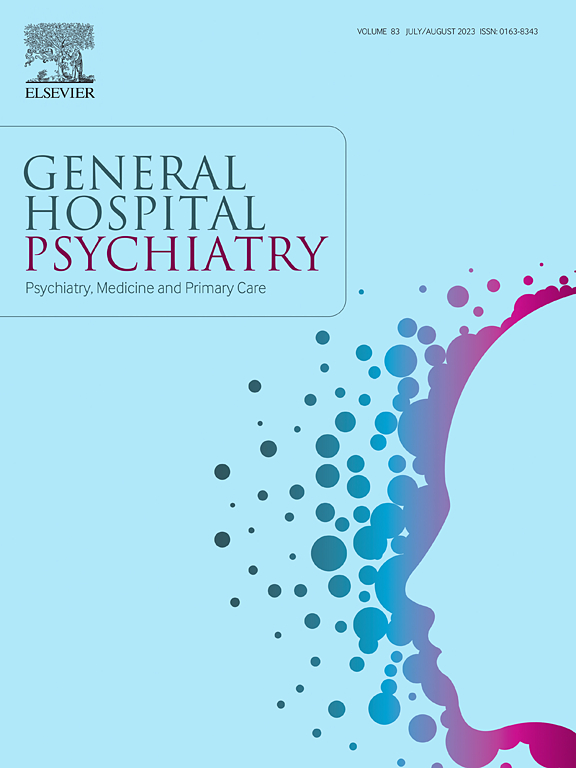抑郁症状轨迹与全因死亡率和过早死亡风险之间的关系:美国和英国的一项10年随访研究
IF 3.7
2区 医学
Q1 PSYCHIATRY
引用次数: 0
摘要
抑郁症已成为世界范围内疾病负担和残疾的主要原因。本研究旨在探讨抑郁症状轨迹、全因死亡率和过早死亡之间的关系。方法采用健康退休研究(HRS)和英国老龄化纵向研究(ELSA)的数据。采用8项CESD量表对抑郁症状进行评估,并将其分为躯体型和认知情感型。采用Cox比例风险模型估计抑郁症状轨迹与全因死亡率和过早死亡之间的关系。结果17930名参与者中,4543人死亡,其中1063人过早死亡。总抑郁症状增加导致全因死亡的风险最高,风险比为2.01 (95% CI: 1.72-2.35),其次是持续高的风险比为1.53 (95% CI: 1.36-1.72),经协变量调整后的风险比为持续低。增加和持续高的总轨迹增加了过早死亡的风险,HR为1.83 (95% CI: 1.29-2.59), HR为2.01 (95% CI: 1.61-2.51)。持续增加的高躯体或认知情感抑郁症状轨迹也增加了全因死亡率和过早死亡的风险。躯体、认知-情感和总轨迹的降低没有显示出更高的过早死亡风险(HR 1.56, 95% CI: 0.90-2.72;Hr 1.00, 95% ci: 0.56-1.78;Hr 1.17, 95% ci: 0.76-1.81)。结论:躯体、认知-情感和总体抑郁症状轨迹的增加或持续高水平与全因死亡率和过早死亡风险升高相关,而轨迹的降低与风险增加无关。旨在减少抑郁症状持续时间的早期干预可能有助于延长寿命。本文章由计算机程序翻译,如有差异,请以英文原文为准。
The association between depressive symptom trajectories and risk of all-cause mortality and premature death: A 10-year follow-up study in United States and England
Background
Depression has emerged as a leading cause of disease burden and disability worldwide. This study aimed to investigate the association between depressive symptom trajectories, all-cause mortality, and premature death.
Method
We utilized the data from Health Retirement Study (HRS) and English Longitudinal Study of Aging (ELSA). Depressive symptoms were assessed using the 8-item CESD scale and categorized into somatic and cognitive-affective subtypes. Cox proportional risk mode was employed to estimate the relationship between depressive symptom trajectories and all-cause mortality and premature death.
Result
Among 17,930 enrolled participants, 4543 died, including 1063 premature deaths. Increasing total depressive symptoms had the highest risk for all-cause mortality with HR 2.01 (95 %CI: 1.72–2.35) followed by consistently high with HR 1.53 (95 %CI: 1.36–1.72) adjusted for covariates compared to consistently low. Increasing and consistently high total trajectories had elevated risks for premature death with HR 1.83 (95 %CI: 1.29–2.59) and HR 2.01 (95 %CI: 1.61–2.51). Increasing, consistently high somatic or cognitive-affective depressive symptom trajectories also increased the risks of all-cause mortality and premature death. Decreasing somatic, cognitive-affective, and total trajectories showed no higher risk for premature death (HR 1.56, 95 %CI: 0.90–2.72; HR 1.00, 95 %CI: 0.56–1.78; HR 1.17, 95 %CI: 0.76–1.81).
Conclusion
Increasing or consistently high trajectories of somatic, cognitive-affective, and total depressive symptoms were associated with elevated risks of all-cause mortality and premature death, whereas decreasing trajectories were not associated with increased risks. Early interventions aimed at reducing the duration of depressive symptoms may help to extend lifespan.
求助全文
通过发布文献求助,成功后即可免费获取论文全文。
去求助
来源期刊

General hospital psychiatry
医学-精神病学
CiteScore
9.60
自引率
2.90%
发文量
125
审稿时长
20 days
期刊介绍:
General Hospital Psychiatry explores the many linkages among psychiatry, medicine, and primary care. In emphasizing a biopsychosocial approach to illness and health, the journal provides a forum for professionals with clinical, academic, and research interests in psychiatry''s role in the mainstream of medicine.
 求助内容:
求助内容: 应助结果提醒方式:
应助结果提醒方式:


